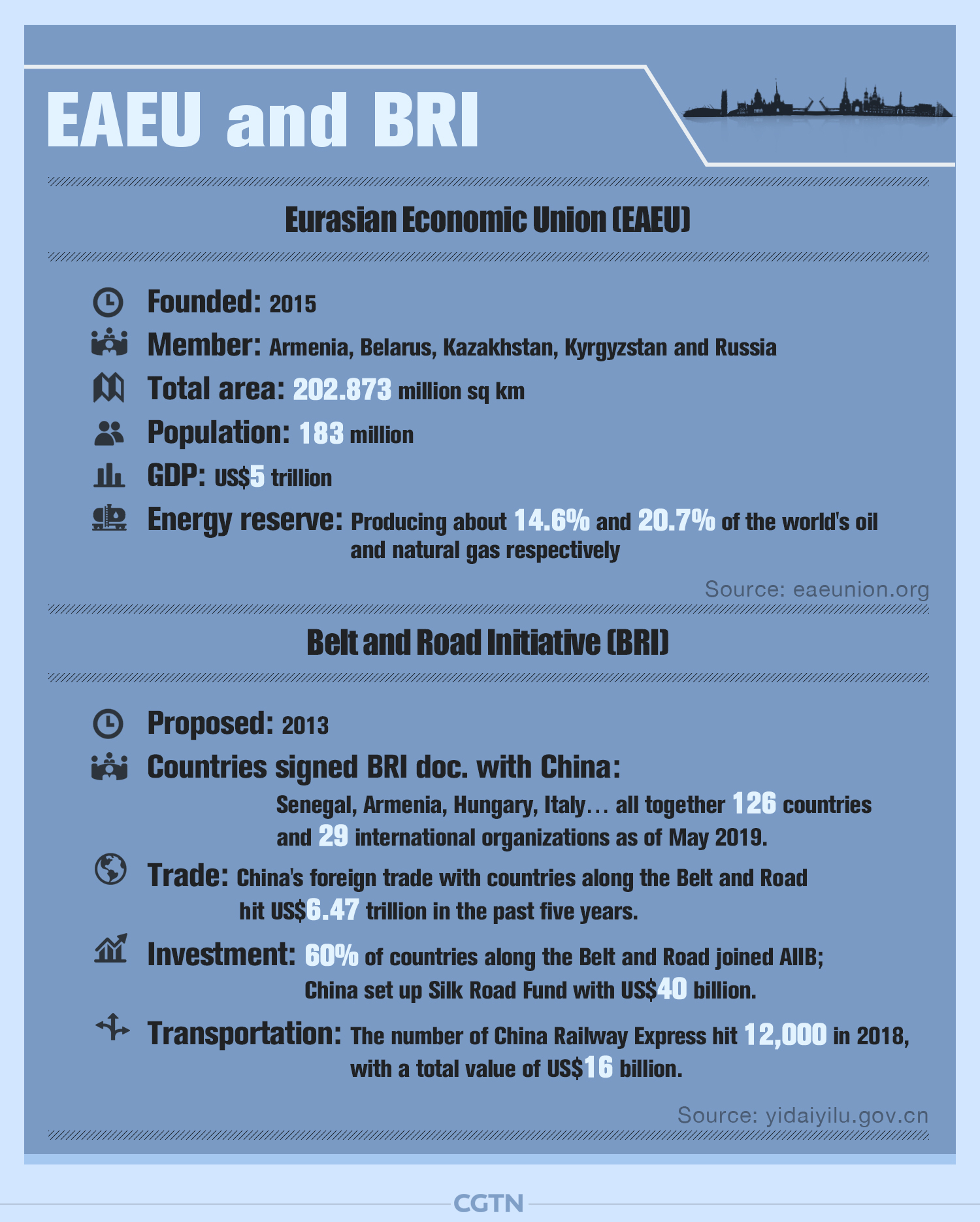
Opinion
20:13, 06-Jun-2019
BRI-EAEU cooperation: A boon for Asia's long-term growth
Luo Yingjie

Editor's note: Luo Yingjie is a professor at the Department of International Politics, University of International Relations. The article reflects the author's opinion and not necessarily the views of CGTN.
With the opening of the 23rd St. Petersburg International Economic Forum, eyes are turning to the cooperation between China and Russia under the Belt and Road Initiative (BRI). Russian President Vladimir Putin attended the Belt and Road Forum for International Cooperation twice in a row, showing great interest in the initiative. What role does Russia play in the BRI and how could the two countries deepen their collaborations within its framework?
First, Russia's unique geographical location and its traditional influence within the Commonwealth of Independent States (CIS) make it an actor of strategic significance for building the "Silk Road Economic Belt" (SREB). For one thing, Russia is covered, as a pivotal state, by the China-Mongolia-Russia Economic Corridor, the New Eurasian Land Bridge, and the China-Central Asia-Western Asia Economic Corridor. This is a distinctive geographic advantage not seen in any other countries along the SREB.
For another, Russia and other CIS member states have maintained political, economic, security and cultural connections that date far back into history. Such sophisticated relationship allows Russia to exert tremendous influence over other member states. In particular, considering that central Asia, a region over which Russia holds greater sway, lies at the heart of the SREB, Russia becomes strategically important in facilitating the development of the economic belt.

A cross-border bridge connecting Russia's Blagoveshchensk and Heihe City, northeast China's Heilongjiang Province, is under construction in Blagoveshchensk, Russia, May 31, 2019. /VCG Photo
A cross-border bridge connecting Russia's Blagoveshchensk and Heihe City, northeast China's Heilongjiang Province, is under construction in Blagoveshchensk, Russia, May 31, 2019. /VCG Photo
Besides, Russia is also practically crucial to the implementation of the BRI as the country recognizes the initiative and proactively aligns its national strategies with it. China and Russia have signed several joint statements with regard to integrating the development projects of the Eurasian Economic Union (EAEU) and the BRI. Therefore, a sound bilateral relationship between China and Russia, together with the increasing prominence given to the BRI by various Russian social sectors, lays a solid foundation for the success of the initiative.

CGTN Infographic
CGTN Infographic
In addition, with Russia being a long-time champion of the EAEU, how to strengthen connections and collaborations between the organization and the BRI becomes a shared concern for Beijing and Moscow. Efforts should be made to promote the development of bilateral and multilateral infrastructure. As the premise for regional economic integration, infrastructure connectivity is noticeably underdeveloped within the EAEU architecture. Therefore, progress in this regard will be in the interest of all states along the SREB including Russia. It is conducive to both the development of China's border areas and the economic growth in the Russian Far East and central Asian CIS countries.
The connective role of the Shanghai Cooperation Organization (SCO) should also be fully utilized. Essentially, the different nature of the BRI and the EAEU, an initiative and a regional integration organization respectively, makes it difficult to structurally connect the two.
However, both are SCO members, and China and Russia can join hands to facilitate institutional alignments in regard to trade, investment and economic cooperation, including coordination of trade and investment rules, technology standards and legal principles within the SCO mechanism. From there unified rules and regulations could be formulated in a bid to forge enabling market conditions to further facilitate and liberalize trade and investment in the region.
Cooperation between China and Russia in infrastructure building will be a great boon to the region at large. It will further harness the potential of regional cooperation between the two countries and promote regional economic growth. As the China-Russia local cooperation mechanism comes of age, the two countries have encompassed almost all areas and sectors of cooperation. The BRI will further unleash cooperation potential between the two countries in trade, investment, tourism, technology and culture, thus greatly boosting regional economic development.
China-Russia BRI-based cooperation will also serve as a demonstrative model for other state and regional members to the project. Joint endeavors between Beijing and Moscow in developing the Russian Far East have brought about positive changes to the area and are already playing a pace-setting role in China-Russia regional collaborations. Inspired by this, more countries and regions have started to more actively engage themselves in the BRI. This year marks the 70th anniversary of China-Russia diplomatic relations. It is believed that the two countries will deepen their cooperation under the BRI and make further contribution to regional peace and prosperity.
(If you want to contribute and have specific expertise, please contact us at opinions@cgtn.com.)

SITEMAP
Copyright © 2018 CGTN. Beijing ICP prepared NO.16065310-3
Copyright © 2018 CGTN. Beijing ICP prepared NO.16065310-3